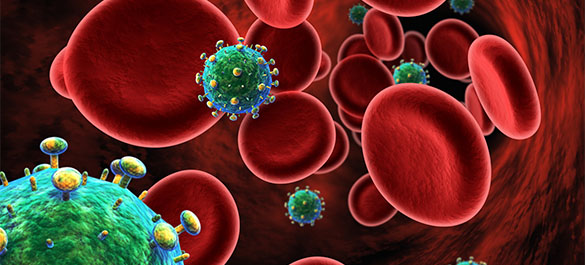
การจัดการภาวะแทรกซ้อนยาต้านรีโทรไวรัส ตอน 7
- โดย ภก.วิชญ์ภัทร ธรานนท์
- 24 กันยายน 2561
- Tweet

การรักษาผู้ติดเชื้อเอชไอวีให้มีประสิทธิภาพสูงสุด ประกอบด้วยหลายปัจจัย อาการไม่พึงประสงค์ของยาต้านรีโทรไวรัสเป็นสิ่งที่แพทย์และทีมผู้ให้การรักษาควรให้ความสำคัญ เพราะ เป็นปัจจัยหนึ่งที่สำคัญยิ่งต่อความสำเร็จในการรักษา อาการไม่พึงประสงค์จากยาต้านรีโทรไวรัสสามารถพบได้ในยาทุกชนิด โดยผลที่เกิดขึ้นในผู้ป่วยบางรายอาจมีความรุนแรงน้อยซึ่งผู้ป่วยสามารถทนได้ หรืออาจมีความรุนแรงมากที่ทำให้ต้องหยุดหรือเปลี่ยนยา และหรือต้องรักษาตัวในโรงพยาบาล อันมีสาเหตุเกี่ยวข้องกับยาต้านรีโทรไวรัสที่ผู้ป่วยได้รับ มีการศึกษาแสดงผลอาการไม่พึงประสงค์ของยาต้านรีโทรไวรัสว่าเป็นเหตุผลที่พบบ่อยที่ทำให้แพทย์ต้องปรับเปลี่ยนสูตรยา หรือทำให้ผู้ป่วยขาดความร่วมมือในการรับประทานยาที่ไม่ต่อเนื่องและไม่สม่ำเสมอ ซึ่งอาจกระตุ้นทำให้เกิดเชื้อเอชไอวีดื้อยาเป็นผลตามมาได้ นอกจากนี้ยังพบว่า ผู้ป่วยติดเชื้อเอชไอวีที่ประสบผลอาการไม่พึงประสงค์จากยาต้านรีโทรีไวรัสจะมีอัตราการเสียชีวิตสูงกว่าผู้ป่วยที่ไม่เกิดอาการไม่พึงประสงค์จากยา แม้ว่ายาต้านรีโทรไวรัสในปัจจุบันจะได้รับการพัฒนาให้มีผลอาการไม่พึงประสงค์จากยาน้อยกว่ายาในสมัยก่อน แต่การรักษาการติดเชื้อเอชไอวีนั้นผู้ป่วยต้องรับประทานยาต้านรีโทรไวรัสไปตลอดชีวิต ทำให้อาจเกิดผลอาการไม่พึงประสงค์ในระยะยาวได้
อาการไม่พึงประสงค์ที่เกิดขึ้นจากการใช้ยาต้านรีโทรไวรัส อาจแบ่งเป็น 2 ประเภทใหญ่ คือ 1. อาการไม่พึงประสงค์ระยะสั้น ได้แก่ ผื่น อาการผิดปกติทางระบบทางเดินอาหาร ภาวะภูมิไวเกิน 2. อาการไม่พึงประสงค์ระยะยาว ได้แก่ ผลต่อการทำงานของไต ผลต่อกระดูก ผลต่อระบบหัวใจและหลอดเลือด และ ผลต่อระบบเมทาบอลิซึมของร่างกาย
ศศิโสภิณ เกียรติบูรณกุล และคณะ พบว่าผู้ป่วยติดเชื้อเอชไอวีชาวไทยที่มีชีวิตมากกว่า 10 ปีภายหลังติดเชื้อเอชไอวี มากกว่าร้อยละ 50 ของจำนวนผู้ป่วยมีปัญหาไขมันในเลือดสูง ร้อยละ 35 มีค่าครีเอตินิน (creatinine) มากกว่า 1 มิลลิกรัม/เดซิลิตร และร้อยละ 5 เป็นโรคเบาหวาน อีกการศึกษาหนึ่งในผู้ป่วยติดเชื้อไอวีชาวไทย พบว่า การใช้ยาเอฟฟาไวเร็นซ์ (efavirenz) สัมพันธ์กับการมีระดับวิตามินดีต่ำ ( < 30 นาโนกรัม/มิลลิลิตร) ซึ่งมีผลต่อกระดูกในระยะยาว และควบคุมระบบภูมิคุ้มกันของร่างกาย ดังนั้น แพทย์และทีมผู้ให้การรักษามีความรู้และความเข้าใจในเรื่องอาการไม่พึงประสงค์จากยาต้านรีโทรไวรัสเป็นอย่างดีจะมีส่วนช่วยป้องกันและแก้ไขปัญหาที่อาจเกิดขึ้นตามมาจากการใช้ยาได้ก่อน และสามารถให้การรักษาอาการไม่พึงประสงค์ดังกล่าวได้อย่างทันท่วงที เพิ่มความปลอดภัยและประสิทธิภาพจากการใช้ยาต้านรีโทรไวรัสได้
ในบทความต่อๆไป ผมจะนำเสนอเนื้อหาเกี่ยวกับอาการไม่พึงประสงค์ที่พบได้จากการใช้ยาต้านรีโทรไวรัสตามระบบต่างๆของร่างกาย พร้อมสาเหตุ การป้องกัน และการรักษาอาการไม่พึงประสงค์ดังกล่าวเป็นประจำทุกสัปดาห์ครับ ขอเรียนเชิญทุกท่านโปรดติดตามด้วยครับ
บรรณานุกรม:
- Department of disease control, Thailand National Guidelines on HIV/AIDS Treatment and Prevention 2017. availavle from http://www.thaiaidssociety.org/images/PDF/ hiv_thai_guideline _2560.pdf.
- Cohen DE, Mayer KH. Primary care issues for HIV-infected patients. Infect Dis Clin N Am 21 (2007): 49–70.
- วีรวัฒน์ มโนสุทธิ. Current management of complication of antiretroviral therapy. ใน: ชาญกิจ พุฒิเลอพงศ์, ณัฏฐดา อารีเปี่ยม, แสง อุษยาพร, บรรณาธิการ. Pharmacotherapy in infectious disease VII. กรุงเทพมหานคร. สำนักพิมพ์แห่งจุฬาลงกรณ์มหาวิทยาลัย. 2558, หน้า 198-201.
- Group TISS. Initiation of Antiretroviral Therapy in Early Asymptomatic HIV Infection. New England Journal of Medicine. 2015;373(9):795-807.
- Group TTAS. A Trial of Early Antiretrovirals and Isoniazid Preventive Therapy in Africa. New England Journal of Medicine. 2015;373(9):808-22.
- Ayoko R. Bossou SC, Karen K. O’Brien, Catherine A. Opere, Christopher J. Destache. Preventive HIV Vaccines: Progress and Challenges. US Pharmacist. 2015 OCTOBER 16, 2015:46-50.
- รัชนู เจริญพักตร์ และ ชาญกิจ พุฒิเลอพงศ์. Current update on HIV/AIDs treatment guideline in 2017. ใน: ชาญกิจ พุฒิเลอพงศ์, โชติรัตน์ นครานุรักษ์, และ แสง อุษยาพร, บรรณาธิการ. Pharmacotherapy in infectious disease IX. กรุงเทพมหานคร. สำนักพิมพ์แห่งจุฬาลงกรณ์มหาวิทยาลัย. 2560, หน้า 342-364.
- Wada N JL, Cohen M, French A, Phair J, Munoz A. Cause-specific life expectancies after 35 years of age for human immunodeficiency syndrome-infected and human immunodeficiency syndrome-negative individuals followed simultaneously in long-term cohort studies, 1984-2008. Am J Epidermol. 2013; 177: 116-125.
- Department of Health and Human Services. Guidelines for the Use of Antiretroviral Agents in Adults and Adolescents Living with HIV Available from: https://aidsinfo.nih.gov/guidelines.
- O'Brien ME, Clark RA, Besch CL, Myers L, Kissinger P. Patterns and correlates of discontinuation of the initial HAART regimen in an urban outpatient cohort. Journal of acquired immune deficiency syndromes (1999). 2003;34(4):407-14.
- Kiertiburanakul S, Luengroongroj P, Sungkanuparph S. Clinical characteristics of HIV-infected patients who survive after the diagnosis of HIV infection for more than 10 years in a resource-limited setting. Journal of the International Association of Physicians in AIDS Care (Chicago, Ill : 2002). 2012;11(6):361-5.
- Wiboonchutikul S, Sungkanuparph S, Kiertiburanakul S, Chailurkit LO, Charoenyingwattana A, Wangsomboonsiri W, et al. Vitamin D insufficiency and deficiency among HIV-1-infected patients in a tropical setting. Journal of the International Association of Physicians in AIDS Care (Chicago, Ill : 2002). 2012;11(5):305-10.
- Wilde JT, Lee CA, Collins P, Giangrande PL, Winter M, Shiach CR. Increased bleeding associated with protease inhibitor therapy in HIV-positive patients with bleeding disorders. British journal of haematology. 1999;107(3):556-9.
- European AIDS Clinical Society. EACS Guidelines version 8.1-October 2016. Available from http://www.eacsociety.org/files/guidelines_8.1-english.pdf.
- ศศิโสภิณ เกียรติบูรณกุล. การดูแลรักษาผู้ติดเชื้อเอชไอวีแบบผู้ป่วยนอก.กรุงเทพฯ : ภาควิชาอายุรศาสตร์ คณะแพทยศาตร์โรงพยาบาลรามาธิบดี มหาวิทยาลัยมหิดล, 2557
- Morse CG, Mican JM, Jones EC, Joe GO, Rick ME, Formentini E, et al. The incidence and natural history of osteonecrosis in HIV-infected adults. Clinical infectious diseases : an official publication of the Infectious Diseases Society of America. 2007;44(5):739-48.
- Woodward CL, Hall AM, Williams IG, Madge S, Copas A, Nair D, et al. Tenofovir-associated renal and bone toxicity. HIV medicine. 2009;10(8):482-7.
- Wang H, Lu X, Yang X, Xu N. The efficacy and safety of tenofovir alafenamide versus tenofovir disoproxil fumarate in antiretroviral regimens for HIV-1 therapy: Meta-analysis. Medicine. 2016;95(41):e5146.
- Redig AJ, Berliner N. Pathogenesis and clinical implications of HIV-related anemia in 2013. Hematology American Society of Hematology Education Program. 2013;2013:377-81.
- Assefa M, Abegaz WE, Shewamare A, Medhin G, Belay M. Prevalence and correlates of anemia among HIV infected patients on highly active anti-retroviral therapy at Zewditu Memorial Hospital, Ethiopia. BMC Hematology. 2015;15:6.
- de Gaetano Donati K, Cauda R, Iacoviello L. HIV Infection, Antiretroviral Therapy and Cardiovascular Risk. Mediterranean Journal of Hematology and Infectious Diseases. 2010;2(3):e2010034.
- Group TDS. Class of Antiretroviral Drugs and the Risk of Myocardial Infarction. New England Journal of Medicine. 2007;356(17):1723-35.
- Tsiodras S, Mantzoros C, Hammer S, Samore M. Effects of protease inhibitors on hyperglycemia, hyperlipidemia, and lipodystrophy: a 5-year cohort study. Archives of internal medicine. 2000;160(13):2050-6.
- วราภณ วงศ์ถาวราวัฒน์. Diagnosis and classification of Diabetes Mellitus. ใน: ธิติ สนับบุญ, บรรณาธิการ. แนวทางเวชปฏิบัติทางต่อมไร้ท่อ. กรุงเทพมหานคร.โรงพิมพ์แห่งจุฬาลงกรณ์มหาวิทยาลัย. 2560, หน้า 1-9.
- ชาญกิจ พุฒิเลอพงศ์. Clinical management for dyslipidemia in HIV-infected patients. ใน: ชาญกิจ พุฒิเลอพงศ์ และ ณัฏฐดา อารีเปี่ยม, บรรณาธิการ. Pharmacotherapy in infectious disease VI. กรุงเทพมหานคร. คอนเซ็พท์พริ้นท์. 2557, หน้า 198-201.
- Dube MP, Stein JH, Aberg JA, Fichtenbaum CJ, Gerber JG, Tashima KT, et al. Guidelines for the evaluation and management of dyslipidemia in human immunodeficiency virus (HIV)-infected adults receiving antiretroviral therapy: recommendations of the HIV Medical Association of the Infectious Disease Society of America and the Adult AIDS Clinical Trials Group. Clinical infectious diseases : an official publication of the Infectious Diseases Society of America. 2003;37(5):613-27.
- Hoffman RM, Currier JS. Management of antiretroviral treatment-related complications. Infectious disease clinics of North America. 2007;21(1):103-32, ix.
- Husain NEOS, Ahmed MH. Managing dyslipidemia in HIV/AIDS patients: challenges and solutions. HIV/AIDS (Auckland, NZ). 2015;7:1-10.
- Kiertiburanakul S, Sungkanuparph S, Charoenyingwattana A, Mahasirimongkol S, Sura T, Chantratita W. Risk factors for nevirapine-associated rash among HIV-infected patients with low CD4 cell counts in resource-limited settings. Current HIV research. 2008;6(1):65-9.
- Murphy RL. Defining the toxicity profile of nevirapine and other antiretroviral drugs. Journal of acquired immune deficiency syndromes (1999). 2003;34 Suppl 1:S15-20.
- Department of Health and Human Services. HIV and Lactic Acidosis. Available from: https://aidsinfo.nih.gov/understanding-hiv-aids/fact-sheets/22/68/hiv-and-lactic-acidosis.
- Grinspoon S, Carr A. Cardiovascular Risk and Body-Fat Abnormalities in HIV-Infected Adults. New England Journal of Medicine. 2005;352(1):48-62.
- Simpson D, Estanislao L, Evans S , McArthur J, Marcusd K, Truffa M et,al. HIV-associated neuromuscular weakness syndrome. AIDS (London, England). 2004;18(10):1403-12.
- Hall AM, Hendry BM, Nitsch D, Connolly JO. Tenofovir-associated kidney toxicity in HIV-infected patients: a review of the evidence. American journal of kidney diseases : the official journal of the National Kidney Foundation. 2011;57(5):773-80.
- Chaisiri K, Bowonwatanuwong C, Kasettratat N, Kiertiburanakul S. Incidence and risk factors for tenofovir-associated renal function decline among Thai HIV-infected patients with low-body weight. Current HIV research. 2010;8(7):504-9.
- Schwarzwald H, Gillespie S. Management of Antiretroviral-Associated Complications. Available from: https://bipai.org/sites/bipai/files/5-Mgt-assoc-complications.pdf
- ศศิโสภิณ เกียรติบูรณกุล. Practical management of complication-associated with ARVใน: นารัต เกษตรทัต, ชาญกิจ พุฒิเลอพงศ์ และ ณัฏฐดา อารีเปี่ยม, บรรณาธิการ. Pharmacotherapy in infectious disease VI. กรุงเทพมหานคร. คอนเซ็พท์พริ้นท์. 2554, หน้า 317-346.


